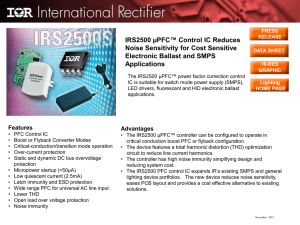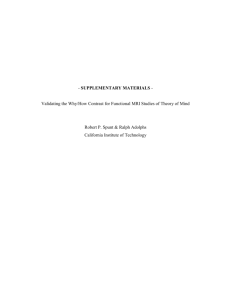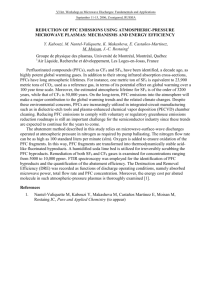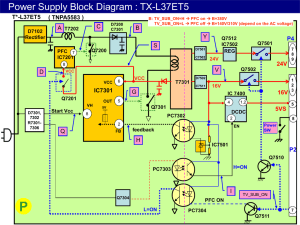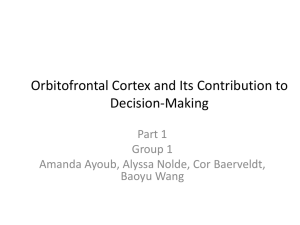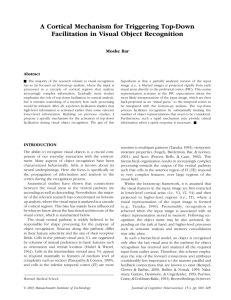Frontal Lobe
advertisement
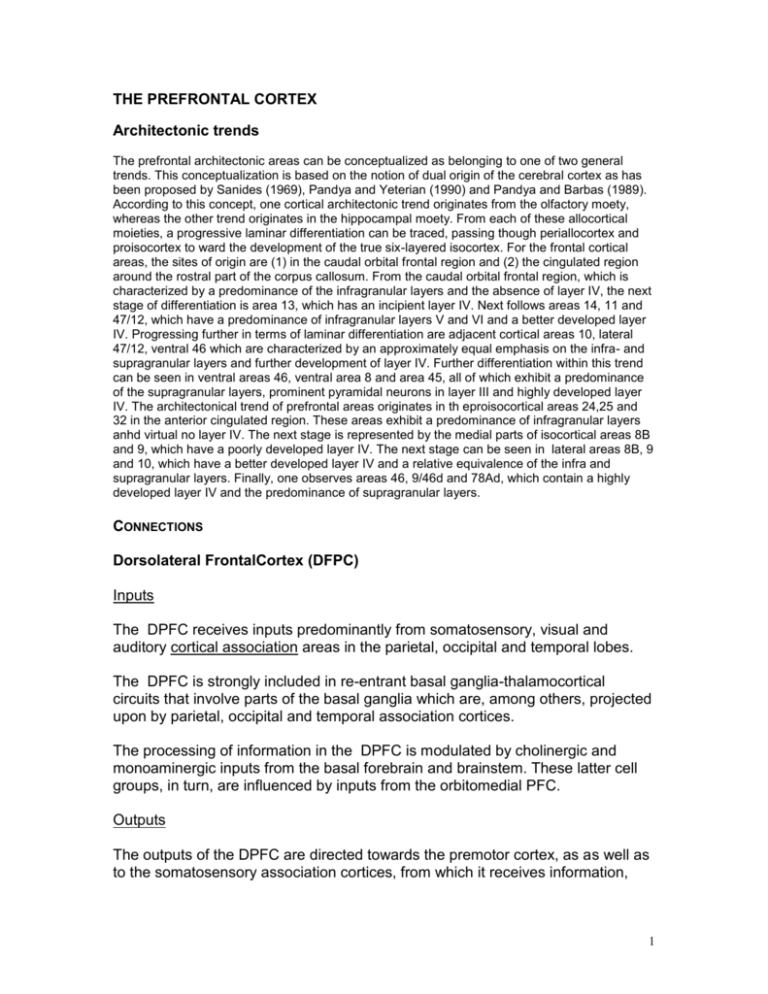
THE PREFRONTAL CORTEX Architectonic trends The prefrontal architectonic areas can be conceptualized as belonging to one of two general trends. This conceptualization is based on the notion of dual origin of the cerebral cortex as has been proposed by Sanides (1969), Pandya and Yeterian (1990) and Pandya and Barbas (1989). According to this concept, one cortical architectonic trend originates from the olfactory moety, whereas the other trend originates in the hippocampal moety. From each of these allocortical moieties, a progressive laminar differentiation can be traced, passing though periallocortex and proisocortex to ward the development of the true six-layered isocortex. For the frontal cortical areas, the sites of origin are (1) in the caudal orbital frontal region and (2) the cingulated region around the rostral part of the corpus callosum. From the caudal orbital frontal region, which is characterized by a predominance of the infragranular layers and the absence of layer IV, the next stage of differentiation is area 13, which has an incipient layer IV. Next follows areas 14, 11 and 47/12, which have a predominance of infragranular layers V and VI and a better developed layer IV. Progressing further in terms of laminar differentiation are adjacent cortical areas 10, lateral 47/12, ventral 46 which are characterized by an approximately equal emphasis on the infra- and supragranular layers and further development of layer IV. Further differentiation within this trend can be seen in ventral areas 46, ventral area 8 and area 45, all of which exhibit a predominance of the supragranular layers, prominent pyramidal neurons in layer III and highly developed layer IV. The architectonical trend of prefrontal areas originates in th eproisocortical areas 24,25 and 32 in the anterior cingulated region. These areas exhibit a predominance of infragranular layers anhd virtual no layer IV. The next stage is represented by the medial parts of isocortical areas 8B and 9, which have a poorly developed layer IV. The next stage can be seen in lateral areas 8B, 9 and 10, which have a better developed layer IV and a relative equivalence of the infra and supragranular layers. Finally, one observes areas 46, 9/46d and 78Ad, which contain a highly developed layer IV and the predominance of supragranular layers. CONNECTIONS Dorsolateral FrontalCortex (DFPC) Inputs The DPFC receives inputs predominantly from somatosensory, visual and auditory cortical association areas in the parietal, occipital and temporal lobes. The DPFC is strongly included in re-entrant basal ganglia-thalamocortical circuits that involve parts of the basal ganglia which are, among others, projected upon by parietal, occipital and temporal association cortices. The processing of information in the DPFC is modulated by cholinergic and monoaminergic inputs from the basal forebrain and brainstem. These latter cell groups, in turn, are influenced by inputs from the orbitomedial PFC. Outputs The outputs of the DPFC are directed towards the premotor cortex, as as well as to the somatosensory association cortices, from which it receives information, 1 probably providing these sensory areas with feed-forward information about motor/behavioral commands. A further output of the DPFC may reach brainstem structures like the deep layers of the superior colliculus, the midbrain tegmentum, and the dorsolateral part of the PAG. Orbitomedial PFC (OPFC) Inputs The OPFC also receives inputs from somatosensory, visual and auditory association areas, but to a much lesser extent than the DFPC; the recipient area is restricted to the lateral and caudal parts of the OPFC. However, inputs from olfactory, gustatory and visceral sources are much more prominent and widespread. The OPFC receives strong inputs from the basal amygdaloid complex and the parahippocampal cortices; inputs from the hippocampus proper reach predominantly the medial wall of the PFC. Outputs The OPFC is involved in re-entrant basal ganglia-thalamocortical circuits that involves parts of the basal ganglia (BG) which are innervated by limbic structures such as the hippocampus and amygdala as well as by limbic associational cortices. There is a reciprocal relationship between the OPFC and the cholinergic cell groups in the basal forebrain and the monoaminergic cell groups in the brainstem and hypothalamus. Through these projections the OPFC may influence the cholinergic and monoaminergic innervation of widespread cortical and subcortical regions of the forebrain. The OPFC further projects to the lateral and posterior hypothalamus, in this way reaching stress and autonomic centers in the brain. In addition, direct brainstem projections reach the ventrolateral part of the PAG, the peribrachial region, the NTS, and the dorsal motor nucleus of the vagus, all involved in autonomic functions. Prefrontal fibers even extend to the spinal cord. In conclusion,the organization of the anatomical connections of the PFC signifies its integrative position in relation to the somatosensory, viscerosensory, somatomotor and visceromotor, cognitive and limbic systems in the brain. 2 Multiple Processing Levels in the Prefrontal Cortex. The lateral PFC is conceptualized as a working memory system devoted to sustaining representations of information stored in the cortex’s more posterior region through selection mechanisms. The anterior cingulate is hypothesized to work in tandem with PFC, monitoring operations of this system (Gazzaniga, 2002). Petrides (1998) proposes a two-tier system in the primate lateral frontal cortex Accordingly, the ventrolateral PFC receive inputs from the sensory cortex and is responsible for their simple maintenance in working memory and for retival of information from long-term memory. The dorsolateral PFC takes this information and performs more executive functions, such as monitoring multiple behaviors and manipulating information. For example, simple rehearsing a phone number is a ventrolateral PFC function while saying the same number backward is a dorsolateral PFC function. FUNCTIOS OF THE PFC Goal-oriented behavior. The PFC has key role in organizing goal-oriented behavior. One must identify a goal; develop subgoals. In choosing among the goals, consequences must be anticipated. Complex actions require that we shift from one subgoal to another in a coordinated manner. One must determine what is required to achieve the subgoals There are often competing goals, the situation may require a response that competes with a strong habitual response, the situation need troubleshooting, or the situation is dangerous or novel, etc. For a person engaged in goal-oriented behavior, especially in a behavior that involves subgoals, it is important that there be a way to monitor progress. Patients with frontal lobe lesions are aware of their deteriorating social situations and have the intellectual capabilities to generate ideas that may alleviate their conditions. But their efforts to overcome their inertia are haphazard at best. They are unable to sustain a plan of action and meet their goals. How the PFC achieve these functions? 1) Represent and maintain information that is essential; 2)Guide task selection and switching tasks; 3)Monitor progress Working memory: Working memory is essential for representing information that is not immediately present in the environment. It allows for the interaction of current goals with perceptual information and knowledge accumulated from past experience. Not only we must be able to represent our goals, but also is essential that these representations persist. Working memory is not only about keeping task-relevant information active; it is also about manipulating that information to accomplish behavioral goals. One of the basic physiological capacities of neurons in the DPFC would be their ability to hold, during a certain delay period between a (sensory) stimulus and the (motor) reaction, sensory (somatosensory, visual, auditory) information ‘on line’ in order to use this information for the guidance of behavior independent of the immediate stimuli. Although neurons in other parts of the cortex may exhibit similar physiological characteristics, it seems very likely, that this capacity of PFC neurons is very important in the 3 adequate selection of behavioral responses, aspects of rule learning (Passingsham), decision-making process. The psychological model of executive control. The Supervisiory Attention System of Shalice. The monitoring System. PET and fMRI imaging studies suggest that the anterior cingulate cortex occupies an upper rung in the attentional hierarchy and ensure interactions among working (in the prefrontal) selection-operation (prefrontal) and long-term memory systems (in the posterior cortex). The cingulate cortex works as a conflict monitoring system, recruites and allocate necessary attentional resources. The PFC, including the anterior cingulate cortex, participate in amplification of representations that are useful for the task and ignore potential distractors. (allocation of attentional resources; dynamic filtering). Frontal lobe patients display heightened interference on the Stroop task (Failure to inhibit irrelevant information) and show perseveration in the: WCST test (Failure to flexible shifting of goals). It is now clear that the basal ganglia are not only the recipient of PFC inputs but also project to the PFC. In view of the strong inhibitory nature of the basal ganglia projections to the thalamocortical systems in ‘resting’ conditions, the PFC has an important role with the BG in behavioral response selection. Rule representation. Miller and Cohen (2001) proposed that reward signals from midbrain dopamine systems act on the multimodal circuitry of the PFC to strengthen connections between neurons that process the information that led to the reward. Maintenance mechanisms in the PFC sustain a circuitry among sensory, motor and mnemonic representations. The PFC produces a feedback signal to the posterior cortex that bias the flow of information along lines that match the PFC representation, ie. along a task-relevant neural pathways. In short, the PFC design a map of which neural pathways in the forebrain are successful at solving a task and then holds it on-line in the PFC so that the rest of the neocortex can follow it. Behavioral and neurophysiological studies also point to the operation of top-down signals on the visual cortex, presumably coming from the PFC that enhances representations of behaviorally relevant stimuli at the expense of irrelevant ones. Social-emotional decision making. The role of the OPFC should be considered in the context of its extensive reciprocal relationships with limbic and autonomic structures. First, the reciprocal relationships with limbic structures, such as the hippocampus and amygdala, provides the PFC with the possibility to gain access to the memory and emotional processes in which these temporal lobe structures are involved, in this way, past experience can be brought ‘on-line’ and may play a role in guiding complex behavioral processes. Second, the reciprocal relationships with the hypothalamic and autonomic systems would provide the OPFC with information about the bioregulatory responses that take place or have taken place in the past in the course of cognitive and socio-emotional decision making processes. This forms the basis for the ‘somatic marker’ hypothesis which proposes that signals from bioregulatory responses, that are aimed at maintaining homeostasis and ensuring survival, are essential for decisions in complex socio-emotional behavior settings. In this way, emotion may have a profound influence on the cognitive functions of the brain. As suggested by Damasio and his coworkers “..too little emotion has profoundly deleterious effects 4 on decision making: in fact too little emotion may be just as bad for decision making as excessive emotion has long been considered to be.” The orbitofrontal cortex seem to be especially important for processing, evaluating, and filtering (inhibiting) social and emotional information. Damage to this region impairs the abilty to make decisions that require feedback from social or emotional cues. In some situations, the responses of patients with orbitofrontal lesions seem overly dependent on perceptual information, ignoring social cues, expectations. Further evidence of the reliance on external cues is that some orbitofrontal patients are prone to imitative behaviors. They often show a change in personality, irresponsibility, and lack of concern for the present or future. A similar loss of social guidance of behavior can be observed in primates after they receive lesions to their prefrontal cortex. The social status of animals that receive lesions of the orbitorfrontal cortex plummets immediately. It is not clear, however, what cues the healthy animals use to reject the lesioned animals so quickly. At times, patients with damage to this region have difficulty inhibiting inappropriate social responses, such as aggressive impulses. Their actions are more often harmful to themselves than others. The role of the OFC in evaluating social cues also has been linked to antisocial behavior. The OFC is the central structure of Damasio’s somatic marker hypothesis. An upcoming decision calls for activating representations of similar events experienced in the past. Damasio argued that affective memories are essential for rational decisions. They allow us to sift through options, alert us to plans linked to negative feelings, and bias us toward ones connected with positive feelings (‘gut feeling’). Somatic markers rapidly narrow the options by automatically anticipating the affective consequences of each action. When the OFC is damaged, the representations required to guide an action are brought into the working memory, but they are stripped of emotional content. Patients with damage to this system might be unable to reach a decision because they become incapacitated by contemplating irrelevant information. None of the outcomes of their actions will be obviously more emotionally preferable than alternative outcomes, and patients might make decisions randomly or impulsively, and as such appear to be disinhibited. A deficient somatic marker system would explain the impairments that patients with damage to the OFC exhibit on the gambling task. The somatic marker hypothesis is somewhat similar to the theory advanced by William James. He proposed that emotional feelings depend on feedback from the autonomic system (see also in the AMYGDALA chapter). A problem with simply using autonomic nervous system signals to identify emotional states, however, is that autonomic states associated with different emotions can be identical. It is perhaps that there is a conditioned association between the autonomic state and various cortical representations. According to Edmund Rolls, the OFC is important for the on-line, rapid evaluation of the stimulus-reinforcement associations. At times, deciding on an action requires that we correct stimulus-reinforcement associations when they become inappropriate based on new information (reversal learning of stimulusreinforcement association). 5 THE CINGULATE CORTEX According to cytoarchitecture, connection and functional properties, the cingulate cortex can be subdivided into four region. The ACC (anterior) is comprised of areas 25,33,24 and 32 and includes a subgenual subregion (SGSR). MCC (middle) includes areas 33’,24’,24d and 32’, the PCC (posterior) is areas 23 and 31 and the caudomedail subregion (CMSR) and the RSC is areas 29 and 30. Areas 24/25/33 are agranular (proisocortical), area 32 (paracingulate) has an incipient layer 4. Area 23, 31 granular-isocortical. Areas 26-29-30 show 3-4 layered transitional (proiso) cortical architecture. The perigenual ACC areas are associated with affective experiences and are directly engaged in autonomic regulation. Electrical stimulation of dorsal perigenual ctx in humans produces fear, pleasure, and agitation. Stimulation of ACC produced the report, “I was afraid and my heart started to beat”, whereas stimulation of MCC evoked a report, “I felt, as I thought I was going to leave”. The former report is of pure fear, while th elatetr is one of an early premotor planning with motivational characteristics. In another series of experiments, the SGSR had elevated blood flow when subjects were involved in face recognition task and the faces expressed emotional content. Finally, autonomic activity is a frequent correlate of emotional behaviors and visceromotor changes (respiratory, cardiac, blood pressure, mydriasis, pioerection, facial flushing, nausea, epigastric sensation, salivation, bowel, bladder evacuation) are the most consistent responses eveoked by electruical stimulation of areas 24 and 25. Perigenual ACC has important connections with structures that directly regulate autonomic activity. Area 25 projects to brainstem and spinal cord autonomic nuclei, including the nucleus of the solitary tract, the dorsal motor n. of the vagus and the sympathetic thoracic intermediolateral cell column. There are also projections to the PAG and reciprocal connections with the amygdale. The MCC areas in the cingulate sulcus have very large layer Vb neurons that project to the spinal cord and supplementary and primatry motor and limbic cortices and account for the many skeletomotor responses evoked by electrical stimulation. These latter responses include gestures, such as touching, kneading, rubbing, or pressing the fingers or hands together and lip puckering or sucking. These areas contain neurons with premotor discharge properties that are coded according to the changing reward properties of particular behaviors. The MCC, however, is not limited to regulating discrete motor activities, functional imaging studies show that it has a major role in cognitive activity associated with response selection, error detection, competition monitoring, divided attention, Stroop interference tasks, working memory etc. 6 PCC-caudomedial retrosplenial ctx in visuspatial-memory functions. Working memory tasks elevate glucose metabolism in the anterior thalamic-RSC system. The RSC-PCC system is also involved in topographic and topokinetic memory. For example, mental navigation along memorized routes elevates blood flow in PCC. 7

